Introduction
What do pension funds, insurance companies, banks, and sovereign wealth funds have in common?
They are all looking for above-average returns in a market with a somewhat unfavorable risk/reward.
This is a trend that started well before 2024.
In 2021, for example, The Wall Street Journal discussed the emerging trend of pension funds moving into riskier alternative assets “to make up for billion-dollar shortfalls and fulfill future retirement promises.“
The quote below is from an interview with Heather Gillers, a pension market expert. I put emphasis on the quote below.
J.R. Whalen: So one way to looking to get those higher returns is through alternative investments. Well, what do we mean by that and what kind of alternative investments are we talking about?
Heather Gillers: So alternative investments are typically not assets that can be traded on the public market, like stocks and bonds, where you know the price, you can buy them and sell them anytime. They’re very liquid. Alternative assets on the other hand are private market assets. They’re typically illiquid. So examples would be private equity where you’re investing in private companies, not in publicly traded stocks or infrastructure like roads and bridges or real estate, apartment buildings. Hedge funds was a long time popular alternative asset that’s lost some of its favor with public pensions. Private credit is one that’s gaining steam. That’s private loans to companies. Not bonds that are traded on the public markets, but private loans. – The Wall Street Journal
Although this interview was held roughly four years ago (time flies, doesn’t it?), it’s still valid, as pension funds’ assets are rebounding, reaching roughly $56 trillion at the end of 2023.
Approximately 20% of this money was invested in alternative assets. That’s up from 12% in 2003.
This is one of the reasons why asset managers are firing on all cylinders. Looking at the chart below, we see that some of the world’s largest asset managers have made the S&P 500 look like a boring value investment over the past five years.
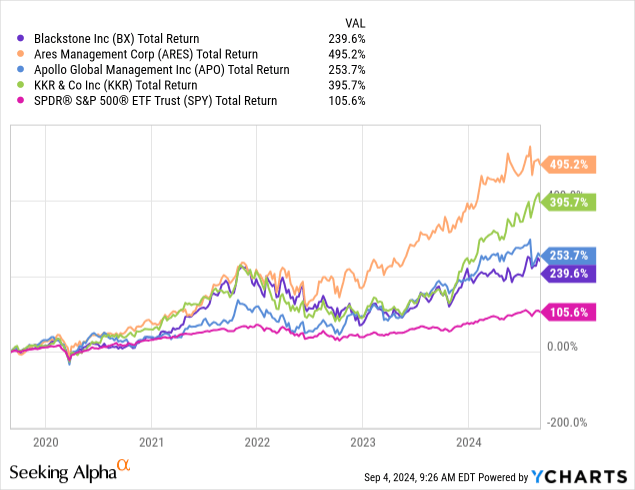
The best performer is the Ares Management Corporation (NYSE:ARES), an asset manager I have never covered before. However, in light of my recent private equity coverage, which you can access here and here, I believe it’s time to dive into Ares, a company that has a very bright future – for many reasons.
So, as we have a lot to discuss, let’s get to it!
Ares’ Fantastic Business Model
Ares was founded in 1997.
Since then, it has built a corporation with roughly $450 billion in assets under management (“AUM”), managed by more than 2,900 employees in 35 offices around the globe.
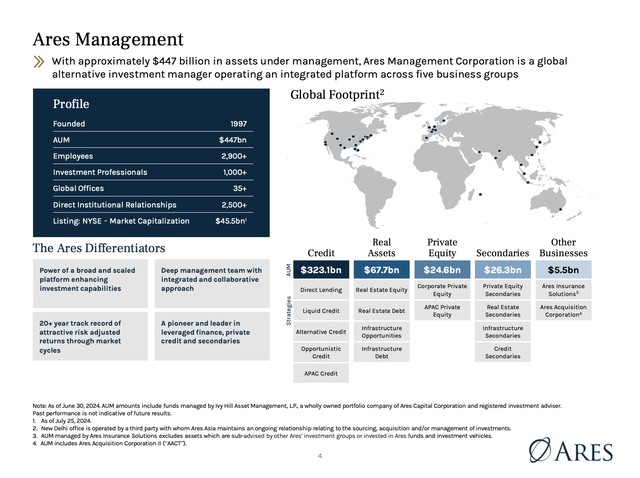
Ares Management Corporation
Moreover, more than a quarter of its AUM comes from pension funds, which makes sense in light of what we discussed in the introduction of this article. Combined, more than half of its AUM comes from pension funds, insurance companies, and banks.

Ares Management Corporation
What sets Ares apart from giants like Blackstone (BX) and KKR (KKR) is its focus on credit.
As we can see in the overview above, most of its AUM is in the credit space. This space manages more than $320 billion, followed by close to $70 billion in real assets and $25 billion in private equity.
Although I am not a big fan of the lending business (I prefer to buy companies who produce something instead of engage in lending), there is no denying that this segment is booming. As we discussed in the first part of this article, it’s the place to be – especially in light of banks becoming more careful.
This has translated to exploding AUM.
In 2011, Ares had $49 billion in AUM. In 2Q24, the company had $447 billion AUM, as I just briefly mentioned. This translates to an annual compounding growth rate of 19%!
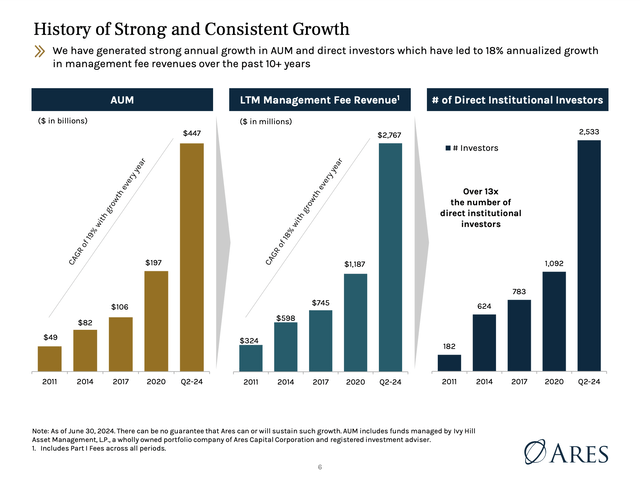
Ares Management Corporation
Because of this rise in AUM, the company’s fee revenues (how it makes money) rose by 18% per year to $2.8 billion in the four quarters ending 2Q24.
After all, the company has three main sources of revenue:
- Management fees, which are based generally on the amount of capital committed to or invested by our funds;
- Carried interest and incentive fees, which are based on the performance of our funds; and
- Returns on investments of our own capital in the funds and other investment vehicles, including SPACs, that we sponsor and manage.
In this case, it helps that 2Q24 was a record-breaking quarter, as the company raised $26 billion in gross capital. The Fed hasn’t even cut rates and the company is already breaking records again.
Even better, it turned 18% AUM growth into 22% higher fee-related earnings.
Roughly $20 billion of its raised capital was deployed in private credit strategies. Over the past four quarters, the company deployed $86 billion, implying an annual compounding growth rate of more than 20% since the four quarters ending 2Q19.

Ares Management Corporation
Based on that context, the company is also seeing tailwinds in areas like real estate, where it is witnessing favorable supply/demand dynamics in industrial and multifamily properties. This is supported by secular trends like e-commerce, economic sponsoring, and demographic shifts.
As most readers may recall, these are the issues we have discussed in countless prior articles as well.
Moreover, Ares Management is capitalizing on high-growth sectors like digital and climate infrastructure, as it has invested almost $5 billion in digital-related infrastructure like data centers, towers, and broadband installations over the past five years.
The company is also increasingly moving into clean energy projects, with $3.2 billion committed to solar, wind, and renewable natural gas sectors over the past five years.
All of these areas have one major benefit: elevated fragmentation.
In prior articles, like my KKR article, I noted that private credit is a $40 trillion industry. Ares has 0.8% of this market. Meanwhile, it has 0.3% of real estate, 0.1% of infrastructure, and 0.4% of private equity.
While it would be somewhat foolish to suggest that any of these numbers could rise to 10% or more, they show that there is a lot of room for consolidation and market share growth in the years ahead.
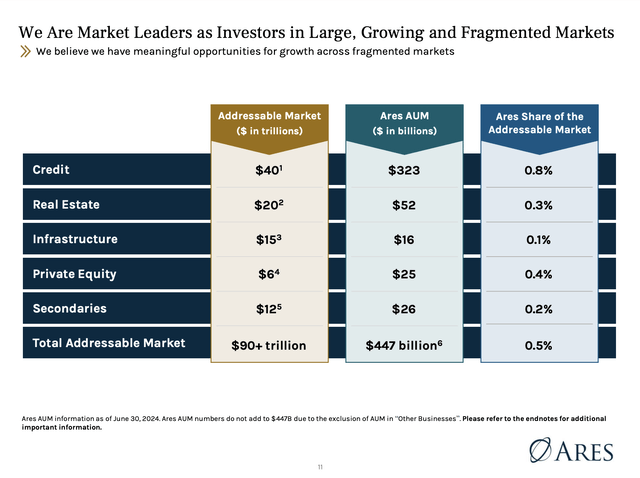
Ares Management Corporation
With regard to future growth, during its 2Q24 earnings call, Ares Management noted it is optimistic due to ongoing solid activity across its investment strategy, supported by favorable economic developments and improving transaction volumes. I have heard similar comments from all major asset managers I have researched in recent months.
The company expects to have 35 funds in the market with 17 unique strategies to capitalize on higher demand for alternative asset allocation. Since 2019, the number of funds with at least $1 billion in assets has risen from 11 to 33, most of them related to credit and real assets.
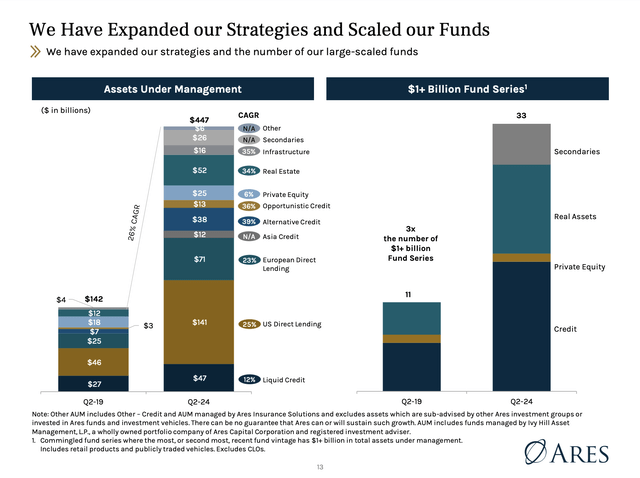
Ares Management Corporation
Ares is also upbeat about the structure of its AUM, noting that its incentive-eligible AUM reached $259 billion. More than $86 billion of this is uninvested, which means it has significant potential for fee growth.
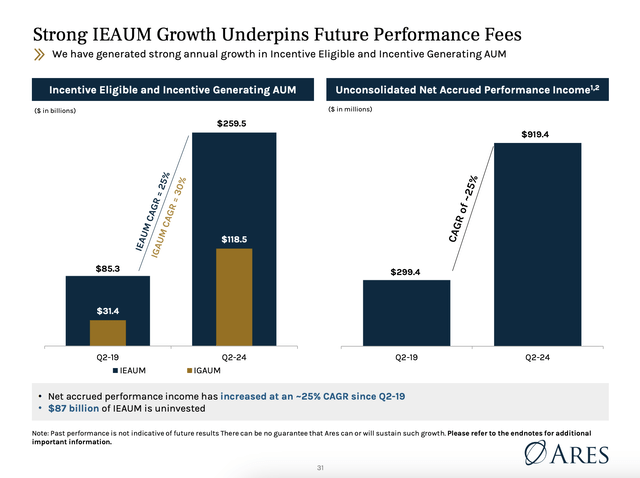
Ares Management Corporation
In general, the company has a highly favorable track record, having grown its fees every single year since 2006, regardless of general credit quality. Even better, current management fee growth rates are higher than in comparable periods.
- 2009-2010: 25% CAGR
- 2019-2021: 27% CAGR
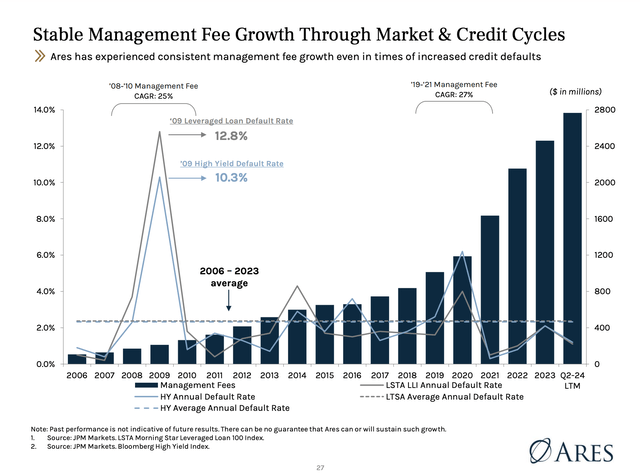
Ares Management Corporation
Over the past five years, management fees have risen by 25% per year. Realized income has risen by 27% per year. This supported a balance sheet with a BBB+ rating from S&P Global and A- from Fitch.
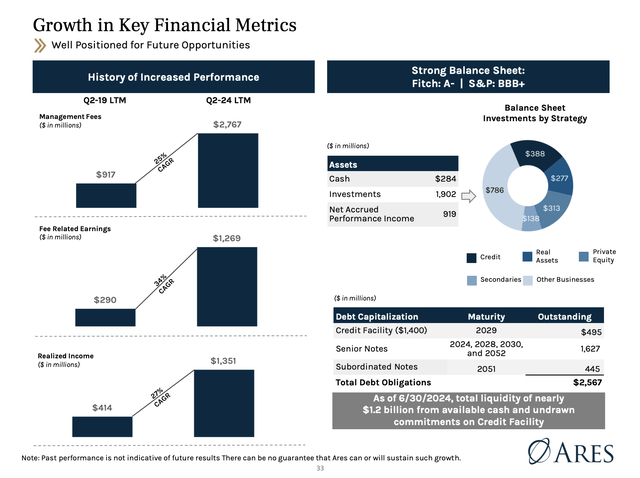
Ares Management Corporation
What does all of this mean for shareholders?
Dividends & Valuation
In recent years, aggressive growth in AUM and fees has made dividend growth much more consistent.
Currently yielding 2.6%, the dividend has a five-year CAGR of 23.2%. The most recent hike was 20.8% on February 8, 2024.

This contributed significantly to the total return of almost 500% over the past ten years.
Unfortunately, ARES is not very cheap anymore.
Currently, the stock trades at a blended P/E ratio of 35.7x, roughly ten points above its five-year average of 24.7x. The good news is that using the FactSet data in the chart below, analysts expect 13% EPS growth in 2024, potentially followed by 40% EPS growth in 2025 and 23% growth in 2026.
This would make it one of the strongest growth streaks in the company’s history.

FAST Graphs
Hence, using its 24.7x multiple, we get a fair stock price target of $175, 23% above the current price. However, this is not a high-confidence target, as the five-year average P/E ratio is more than five points above the 20-year average.
This means a lot of good news has been priced in, even if we assume investors remain very upbeat about the private equity/lending industry, which I expect will be the case.
The current consensus price target is $150.
Although I will give ARES a Buy rating, I would not deploy a lot of cash at current levels, as a correction is needed to juice up the risk/reward.
Takeaway
Ares is on a roll, with explosive growth in assets under management and impressive fee revenue increases, driven by its focus on credit and alternative investments, both of which are booming industries.
Meanwhile, its ability to capitalize on market trends, like the growing demand for private credit and real assets, puts it in a great spot for future gains.
However, the current valuation isn’t a bargain, with a P/E ratio well above its historical average.
While I’m optimistic about the asset manager’s long-term prospects and rating it a Buy, it may be prudent to stay patient and wait for a pullback to deploy more capital.
In general, this is a stock worth watching closely.
Pros & Cons
Pros:
- Strong AUM Growth: Ares is firing on all cylinders, with a 19% annual growth rate in AUM, hitting $447 billion recently. This has translated into elevated fee revenue growth.
- Diversification: With management fees, carried interest, and returns on its own investments, Ares has multiple ways to generate income, most of which enjoy secular growth.
- Expanding Market Share: Ares has significant room to grow in highly fragmented markets like private credit, real estate, and infrastructure.
- Solid Dividend Growth: With a 23.2% five-year dividend CAGR and a yield of 2.6%, Ares has an attractive dividend.
Cons:
- High Valuation: ARES trades at a P/E ratio of 35.7x, which is significantly above its five-year average. Although EPS growth is expected to be elevated, the room for error is slim.
- Cyclical Risks: The company’s reliance on private credit and alternative assets could face headwinds in economic downturns.
Read the full article here
